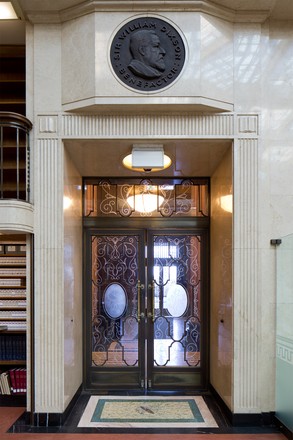Glass doors of the Mitchell Library Reading Room
1942
Sandblasting by Grainger Glass Company
The three sets of sandblasted glass and bronze doors leading from the vestibule into the Mitchell Library Reading Room were inspired by the 16th-century French book collector and binder, Jean Grolier. The pattern of interlacing scrolls on the glass and brass surrounds is based on the design that features on the leather and metal covers of Grolier’s books. The central reliefs of the doors, based on watermarks from old handmade papers, are also symbolic of Grolier’s story. The doors on the left feature a dolphin, the official symbol of the province of Dauphiné, Grolier’s birthplace. Etched into the centre doors is a pair of coats of arms, consisting of a shield, fleur-de-lis and crown. These are symbolic of the French kings Louis XII and Francois I, under whom Grolier served as a diplomat to Italy from 1506 to 1521.
The doors on the right show images of griffins in a style sourced to the Italian Renaissance to acknowledge Grolier’s Italian heritage as well as the time that he lived in Milan. Griffins have been used to represent guardian spirits since Greek antiquity, and are still used as symbols of state in many Western cultures, for example, Britain, France, Flanders and Germany.
Mummy’s initials
While working at his
father’s glass decorating business in 1941, Llewellyn ‘Ross’
Harradence was put on the job of decorating the glass doors for Library. At the
time, his girlfriend was Marion D Philpott, and he etched her initials ‘M.D.P.’
into one of the door panels. Ross and Marion later married. Bringing their four
sons to the Botanic Gardens in the 1950s, they would come by the Library to see
‘Mummy's initials’. But unfortunately for the boys, the original panel was
broken and when it was replaced by the Harradence company, the initials were
omitted.
The extraordinary library of Jean Grolier
Born in Lyon of Italian descent, Jean Grolier was introduced to the French Court by his father. In 1508 he became secretary to the king, and accompanied Louis XII and later Francois I throughout France and Italy. In 1534 he was appointed ambassador to Pope Clement VII and it was during this time in Rome that he started collecting works for his great library. In the words of the French historian Jacques-Auguste de Thou, ‘only books as were remarkable for their intrinsic literary value and their beauty of form’ were included:
The Greek and Latin classics, the works of contemporary philosophers and learned men, historians, geographers, archaeologists … By the side of these figured the modern Latin poets, which were read at that time, and the literature of Italy. He had the frontispieces and the initials painted in gold, and in colours. The covers bore ornaments in the most exquisite taste, and were gilded with remarkable delicacy. The compartments were painted with various colours, were perfectly well-drawn, and all were designed in different figures. But it is particularly in the bindings which he caused to be made, that Grolier gave the most positive proofs of his admirable good taste. The art with which they were executed was no less remarkable than the beauty of the ornaments which he himself designed. To-day the richest public libraries account it an honour to possess books bound by Grolier.*
Footnotes
*Jean Grolier Club (1884- present)
http://www.grolierclub.org/Default.aspx?p=DynamicModule&pageid=289377&ssid=168500&vnf=1



 Back to list
Back to list